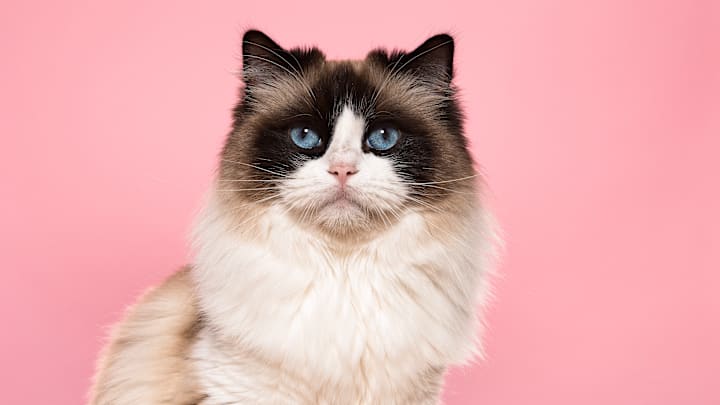The Ragdoll cat can be described in three words: big, beautiful, and friendly. With silky, medium-length fur that's similar to a Persian or Angora and the sizable body—and affable personality—of a small puppy, the Ragdoll is a favorite breed among cat fanciers. Here are seven facts about America’s most popular cat breed.
1. Ragdolls are lap cats.
Ragdolls thrive on human companionship, and, unlike some other felines, they love being held. In fact, the breed supposedly got its name because early litters of the docile, friendly cat became limp and floppy like rag dolls when they were picked up.
2. It's a relatively new breed.
Ann Baker, a breeder who lived in California during the 1960s, is credited with creating the Ragdoll (she also trademarked the name). Baker took a domestic longhaired white female that was found running wild in her neighborhood, and bred her with another long-haired cat. The resulting kittens were the progenitors of the Ragdoll breed. By selecting for traits like a friendly personality and long, plush fur, Baker eventually produced the big, soft kitty we know and love today.
One of the cats in the original Ragdoll bloodline may have had Siamese-like markings, or Baker mated that first cat with Birman, Burmese, or Persian cats. However, since nobody quite knows which cat breeds Baker used to create the Ragdoll, the origin of the breed’s classic color-pointed coat (a term that’s used to describe a body that’s lighter than its “points,” including the face, legs, tail, and ears) remains a bit of a mystery.
3. Ragdolls have beautiful blue eyes and gorgeous coats.

Aside from its plush fur and large body, the Ragdoll is known for its bright blue eyes and color-pointed coat. Ragdolls also come in a variety of shades, ranging from seal (brown) and blue to red and cream. Variations like tortoiseshell and tabby markings are also common. Ragdolls come in several patterns, including colorpoint (no white on their coat), bicolor, and mitted (meaning they have white “mittens” on their paws). They're born pale, and their coats gradually darken into their permanent hues as they grow older.
4. They're one of the largest cat breeds.
According to the Cat Fanciers’ Association (CFA), male Ragdolls typically weigh between 15 and 20 pounds, and females between 10 and 15 pounds. That makes them slightly larger than other feline heavyweights like the Maine Coon, which can weigh up to 18 pounds, and the Norwegian Forest Cat, which can weigh up to 16 pounds.
5. Ragdolls are quiet kitties.
Ragdolls are affable and quiet. Thanks to this trait, Realtor.com once named them as one of the best cat breeds for apartment living. However, this trait also has a downside: Your Ragdoll may not meow if it’s distressed or in pain—so make sure to treat it with care.
6. A Ragdoll was the world's longest-living "Janus cat."
A feline born with two faces is called a Janus cat—a name that’s inspired by the Roman god Janus, who is often portrayed as having two faces. The world’s most famous two-faced cat, Frank and Louie (also known as Frankenlouie) was a Ragdoll. He had two functioning eyes, a blind central eye, two noses, and two mouths.
Frankenlouie’s deformity was caused by a very rare congenital condition known as diprosopia. He wasn’t expected to live very long, but a woman named Marty Stevens rescued him from being put down. Frankenlouie lived for an astounding 15 years before he passed away in 2014. Thanks to his long lifespan, Frankenlouie is listed by Guinness World Records as the longest-lived Janus cat.
7. Ragdolls are "dog-like" cats.
Ever wanted a pet that will play fetch with you, follow you from room to room, and sleep with you in your bed? If you’re allergic to dogs (or you’re just partial to cats), consider a Ragdoll. "They can be more like dogs than cats sometimes," one Quora user wrote. "My cats greet me at the door, follow me from room to room, cuddle up next to me on the couch and in bed, wait outside while I take a shower ... etc., etc. They love stuffed animals and little toys which they will carry from room to room. One of them even plays fetch. If you are looking for a more independent animal, the Ragdoll is not for you; they demand and need a LOT of attention and play."
A version of this article originally ran in 2016; it has been updated for 2022.
